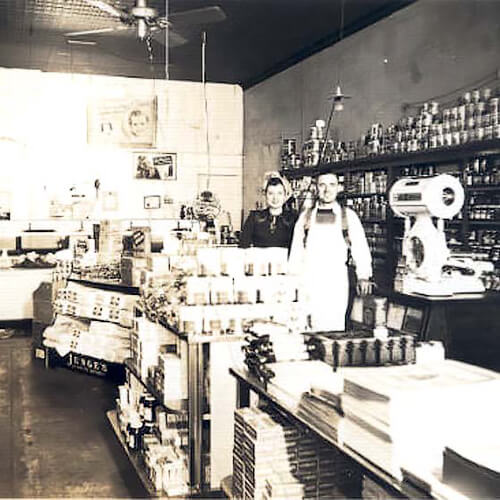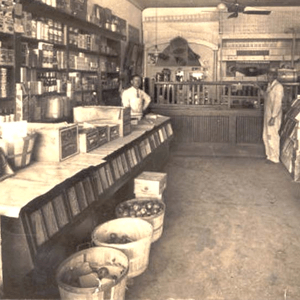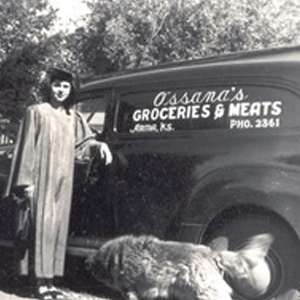The small community grew with the arrival of emigrants from all over Europe to work in the coal mines. Many businessmen hired girls with different ethnic backgrounds to help their customers who spoke no English. However, Otto learned enough of each language spoken by his customers to meet their needs. Several of his seven children worked, from time to time, in the store.
These were the days of high tin-patterned ceilings with wooden-bladed fans that swirled above the customers heads during hot summer months. A rather large coal stove downstairs was used to heat the store and the apartment above the warehouse that ran the entire length of the building, just east of the attached store.
A customer could have custom cuts of fresh meat in any amount, freshly ground coffee, and crackers, cookies, pickles and everyday commodities plucked out of wooden barrels, or from drawers found behind viewing windows for various tantalizing foods.
The family business weathered and proved itself through the rigors of infancy and survived the Depression during its maturity.
Otto‘s youthful drive made it possible for him to raise livestock which was processed in his own slaughter house located at his residence at 701 Long Avenue near the southeastern edge of Arma. He had bought the land from Andrew Allen and built the house in 1916.
By the time Otto was thinking of retirement, World War II was almost over. He desired to see the business remain a family tradition. After several options were considered, his twenty-eight year old son, Joe, was convinced to return home from the army to become the new owner. Joe brought with him his wife Ava Margueritte Showalter Ossana (born July 3, 1923) from the Wichita area. They were married in the Rose Hill Methodist church on April 5, 1942.
Lena Bertha Ott Ossana died March 12, 1963 in Mt. Carmel Hospital, off Atkinson Street. Otto died at his home on August 26, 1965, after more than a decade of fighting cancer.
The grocery business in 1946 was much the same as it had been for years. Groceries were still delivered to the housewives’ door until the mid-1960s. There were seven groceries stores in Arma in the 1940s and 1950s, all about the same size. Saturday continued to be a festive day when all the farmers and miners came to town to add to the crowd of people on the streets and in the stores.
Joe continued the same tradition of processing his own meat to the customer’s satisfaction. He purchased the livestock from area farmers or the Parson’s stockyard. Eventually, he became too busy in the store to give time to the slaughter house. Consequently, he ordered meats from several packing houses in the ten-county area of southeast Kansas, including the Menghini Brother Meat Packing Plant in Frontenac. The Menghini brothers had also come from Tyrol as Otto Ossana, Sr. had years earlier, and proved to be true friends in business and socially.
In the 1950s, Joe began to branch out making tasty sausages (smoked and fresh pork, and small breakfast links), garlic and hard salami, chili bricks, beef jerky, porketta, blood sausage and more. These delicatessen items were taken far and wide across the United States and even aboard to some small degree over the years.
During U. S. Senator Joe Skubitz’ service in Washington, D. C., he would come to purchase Dad’s sausage. It was served in the U. S. Capitol cafeteria.
The secret to the much sought after deli items, particularly the sausage, was to keep the recipe simple instead of adding conflicting spices that cancelled each other out. He had the favor of several “old timers” who initially shared recipes that he perfected over the years, and who also showed him how to make the most effective smoke house.
When other businessmen who wanted to make smoked sausage and other meats came to ask for help, he passed on the secrets of how to build a smoke house that properly cured the meats. In one instance, a family came to get the information and tried to improve on the idea by changing the construction and procedure of their smoke house only to find that the meat was not properly cured. They had to come back to get the exact information once again. They have since succeeded with the dimensions, distance from the fire, temperatures, and length of curing. Dad’s experience proved itself valuable.
When Dad rendered lard, he would cover the wood-heated vat with a muslin cloth so we could cook potato chips as the hot lard was poured over the cloth. It was something we looked forward to and is a good memory to this day.
My brother or I often accompanied him to the Pittsburg Fadler’s wholesale warehouse (located in the last Monsour building on Elm Street and Marrone’s (housed in the present site of Bricktown on Pine Street). Dad would make selections of vegetables and fruits that were needed at the store between the deliveries made to Arma. It was always interesting to watch the tarantulas move under the cover of their thick nests of white gossamer webbing on the ceiling of the banana room at Fadler’s.



